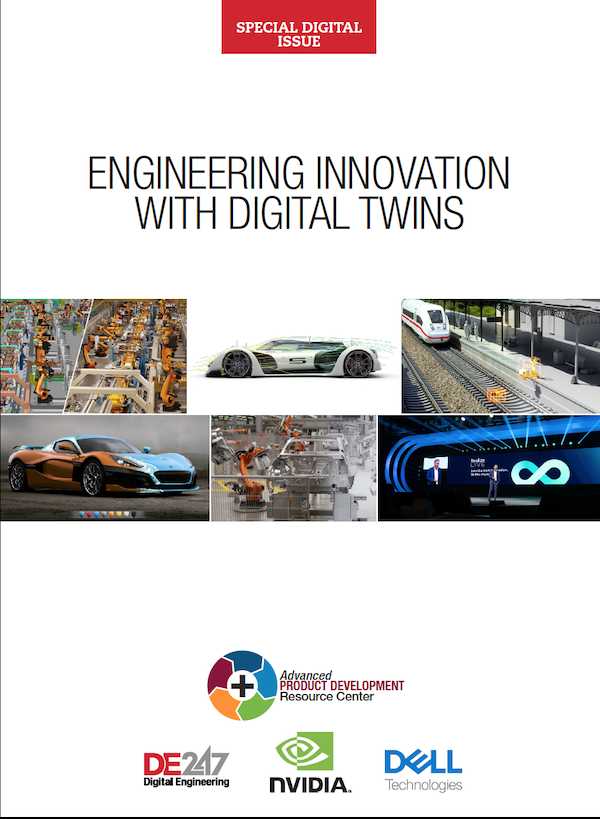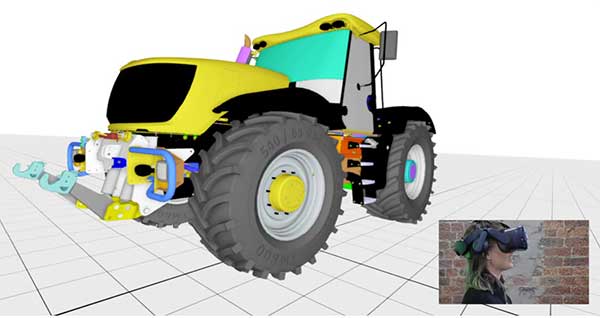
VR enables users to analyze digital twins on a human scale, extending familiar interactions into an immersive 3D environment. This trend is being driven in part by the increasing footprint of PLM support for lower cost VR devices, such as the HTC Vive, Oculus Rift and the zSpace device. Image courtesy of Siemens Digital Industries Software.
Latest News
January 4, 2021
Digital twin technology conjures up visions of many benefits, promising dramatic improvements in the design, manufacture and maintenance of products and processes. Look closer, factor in the impact of the Internet of Things (IoT) and the increasing complexity of assets, and you begin to realize that twin innovation brings a new set of challenges. Ironically, these challenges are based as much on human shortcomings as they are on technical issues.
The problem lies at the core of a digital twin. These virtual replicas are by definition vessels that hold huge amounts of data, enough at least to represent a complete record of an asset. To complicate things further, this record must be constantly updated to ensure real-time accuracy throughout the asset’s lifecycle. All this translates into mountains of data, even after artificial intelligence (AI) data filters out data of little value.
Here’s the rub: How do you present data in such a way that users can easily digest and understand large amounts of complex data that come into play with digital twins? Increasingly, the engineering community’s answer is: virtual reality (VR) and augmented reality (AR).
Context Complications and Opportunities
Most technologists would agree that VR has the potential to enhance the use of digital twins (Fig. 1), but this doesn’t open the door for blanket implementation of VR technology. Certain elements must come into play before the visualization technology delivers its full value.
One factor is context. In this case, context represents the combination of digital twin configurations and operating conditions in which the asset must operate. For example, a configuration element might be the viscosity of the gear box oil in a wind turbine. Operating conditions, on the other hand, might be ambient temperature, terrain or wind conditions.
Context is important in digital twin projects because it introduces a level of variability that can complicate design or design refinement processes. The variability springs from the fact that a digital twin’s configuration can vary significantly depending on the operating conditions.
“You can have two ‘like’ assets, right next to each other, each having its own unique configuration and product data history,” says Jason Kasper, product marketing manager at Aras.
This variability precludes using a one-size-fits-all design approach. For most VR use cases, the designer wants the exact representation of conditions in the field, in its environment. The greater the fidelity, the greater the accuracy and the greater the design efficiency. As fidelity decreases, VR’s value declines.
As a result, the designer must include all relevant product data for each asset configuration. Skip this process, and the development team is exploring a conceptual model, not the reality in the field.
On the plus side, the same variability created by context also presents designers with an opportunity to leverage one of VR’s strengths to make significant improvements to design efficiency. For instance, VR-assisted design evaluation moves the process from a flat screen to a virtual 3D environment, which overcomes distortions and limitations of 2D screens and allowing the engineers to more intuitively evaluate the asset’s design.
VR also allows design evaluations to transcend certain physical limitations. With a slight change on the controller, a designer can alter the asset’s material, texture, color and parts to review the impact of design changes. The virtual asset can also be placed in any given environment or time to evaluate the effects of the operating conditions.
All this speeds up the evaluation process—where the real costs and time-consuming tasks are— and allow design teams to simultaneously bring dozens of design proposals into the VR environment, review them in any arrangement or from any orientation, and weigh the impact of each configuration or design change early on.
A New Digital Twin Perspective
Part of the enhanced efficiency brought by VR to digital twin springs from the fundamental nature of the visualization technology. In VR’s immersive environment, engineers can view and analyze the twin, at scale, engaging human sensory perception—such as touch, spatial awareness and depth perception—which is often impossible in a 2D environment.
Through interactive simulations, based on real proportions and body measurements, more effective products can be created. Further, VR can ensure easier maintenance using a haptics interface, navigation and manipulation through interactive touch.
These features allow design teams to assess ergonomic factors such as sight lines, reachability and clearances, resolving design conflicts earlier in the asset’s lifecycle. They also make traditional design processes such as digital mockup functions—such as interference and clearance analyses, sectioning and positioning—more intuitive.
“There are processes that significantly benefit from a VR experience, such as being able to mount or dismount components, where you can use a controller to pick up a part and get haptic feedback when the part touches another one,” says Kilian Knoll, product manager for Teamcenter Visualization, Siemens Digital Industries Software. “So, we are combining the strengths of VR input devices with a real-time collision and path planning capability, which allows the user to get their job done faster.”
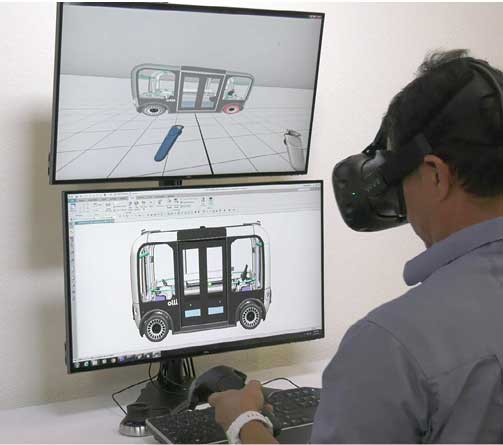
VR also enables a personal connection to data. The immersive paradigm has a cognitive and emotional aspect to it that is not experienced by looking at digital twin representations on a flat screen. When a user is volumetrically surrounded by data, it provides a level of correlation to the digital twin that is intuitive (Fig. 2).
Making Design Experiential
All these factors help the engineer to overcome one of the greatest challenges encountered in the design process: clearly conveying an idea when relying on models and drawings. Even with today’s 3D renderings, non-designer stakeholders often find it difficult to grasp all of a design’s components and implications.
Using an immersive VR environment, both designer and client can experience walking around a space, viewing details from any angle and understanding its composition. The immersive technology builds common ground that facilitates better understanding of the issues that arise during the design, development and redesign processes.
“Combining the extended realities with other forms of digital and physical assessments results in experiential problem-solving,” says Elizabeth Baron, enterprise solutions executive at Unity Technologies. “Because immersion is a holistic paradigm, as the digital twin is as well, a user can represent a problem from many points of view. Immersion brings things to a common understanding of the product.”
Making Digital Twins More Collaborative
VR’s experiential nature points to two of the visualization technology’s greatest strengths: enabling new levels of collaboration and facilitating easier understanding of complex design data.
At its core, immersive VR is a social paradigm that functions on a global scale. The technology allows users to amplify meaningful communications and create scalable, connected spaces, where all users, regardless of their location, can relate and evaluate digital twins.
“When a cross-functional, globally connected team meets in an immersive environment, it creates a forum where every discipline is properly represented in context, and complex stories are told amongst the multidisciplinary teams,” says Baron.
This is seen when VR is used to perform design reviews. Here, stakeholders of varied disciplines, using a common data set, can visualize, analyze and mark up the twin-based designs. Some platforms even save the data created during VR design reviews back to the design structure, including markups and annotations, making the data visible to all stakeholders.
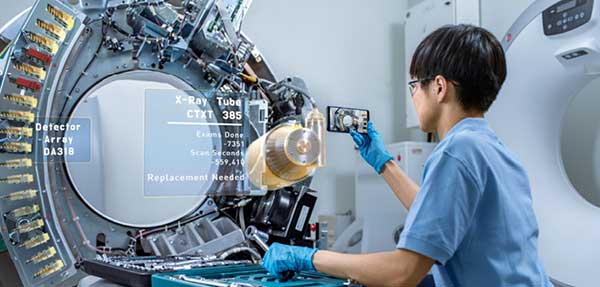
“Performing virtual design reviews in real time is a key enabler,” says Siemen’s Knoll. “Supporting virtual conferences reduces ambiguity and speeds up the decision-making process significantly. As an example, pointing to an issue in real time and redlining it is like a whiteboard on steroids.”
Cutting Collaboration Costs
To maximize the technology’s benefit for digital twin users, VR platforms should work with low-cost, mainstream VR devices, such as Oculus Rift and HTC Vive. This trend has been driven by the cost reductions witnessed by the market over the past couple of years.
“One of the barriers to adoption has been significantly lowered by the price reductions,” says Knoll. “For example, a Cave that used to cost up to a six-digit investment with dedicated rooms and custom hardware can now be replaced with low-cost VR headsets, controllers and trackers that can be purchased online.”
Some product lifecycle management (PLM) based VR platforms extend collaboration services to users who do not have access to specialized VR hardware. This allows desktop users to see the avatars of immersed conference participants.
“Bringing multiple data sources into context that can be experienced on any platform is the hallmark of a successful deployment of digital twin,” says Baron. “It is important, therefore, that all platforms are supported.”
AR—Right Data at the Right Time
In addition to enhancing digital twin applications with VR technology, today’s engineers can also avail themselves of another visualization technology—AR. Unlike VR, which completely immerses the user in a computer-generated reality, AR overlays contextually relevant images, text and other digital information over real-world images.
Distinctly different from its virtual cousin, AR brings its own benefits to digital twin applications and carves out a unique set of use cases. Engineers can use AR to overlay the digital twin of a piece of equipment to visualize the machine’s inner workings and understand its data flows; to assist technicians deploying or maintaining the system; or to help automation engineers see how a piece of equipment best fits in a manufacturing workflow (Fig. 3).
AR capabilities help users better digest digital twin information, leveraging its ability to contextualize information. In this case, context means showing the right amount of information, for the right job and right skill set, empowering users to make the most appropriate decisions because they have everything they need, when they need it (Fig. 4).
“Historically, technicians were required to flip through a 1,000-page manual while conducting very complicated repairs,” says Marc Schuetz, vice president of augmented reality product management at PTC. “With the emergence and adoption of AR, technicians can now leverage the digital twin in an easier way to visually walk them through any potential repairs. Being able to overlay such information provides the context to help technicians understand why the repair is necessary and how to perform it fast and safe.”
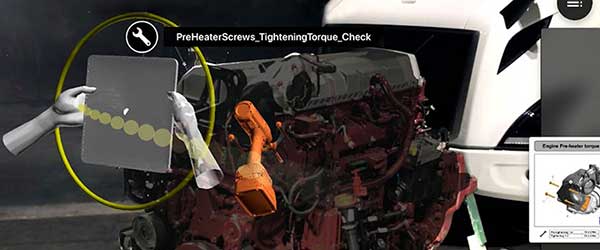
AR promises to enable design and development teams to transcend diverse differences of expertise and functional concerns. This translates into making data more accessible to all stakeholders.
“AR gives stakeholders across all disciplines greater access to digital twin data,” says Schuetz. “While previously someone could have gone back to their desk to look something up or review a manual, now using the devices they already have on them, they can access the right guidance, based on the context of what they’re looking to accomplish. The ease of getting the right information, in the right way, for the right context results in the data being more accessible to users.”
Moving Forward
Though the convergence of digital twin, AR and VR is still in the early days of the evolution, signs do point to a path the trend will follow.
Visualization and PLM tools supporting digital twin appear to be evolving from stand-alone platforms to interconnected suites of tools. The complete representation of an asset required by digital twin, consisting of multiple data sources available at any time, requires an integration of technologies for communication and content distribution.
“Data visualizations with CAD tools or AR or VR systems do not inherently need to be distinctly different from the user’s standpoint,” says Baron. “The goal is to have the digital twin process deliver the visualization platform requested by the user. This would realize efficiency improvements in having a single source of truth in data to resolve system-to-system interfaces for product and process issues.”
The need for data integrity will play a leading role in shaping the architectures of digital twin-visualization suites.
“Integrating PLM with other software tools helps to ensure all around data integrity, allowing for the correct view of the digital twin and ensuring all stakeholders can participate in the product lifecycle,” says Knoll. “We are seeing a significant uptick of customers extending the usage of VR with desktop applications tightly integrated to the PLM system, as well as establishing processes that allow the use of AR driven by the PLM system.”
More PTC Coverage
More Siemens Digital Industries Software Coverage
Subscribe to our FREE magazine, FREE email newsletters or both!
Latest News
About the Author
Tom Kevan is a freelance writer/editor specializing in engineering and communications technology. Contact him via .(JavaScript must be enabled to view this email address).
Follow DERelated Topics






